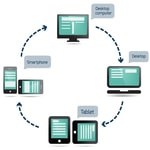
What is DevOps?
What is DevOps?
DevOps is an effective concept which automates the progressions between software development and IT team. DevOps helps in building, testing, releasing software rapidly and more consistently, solve crucial issues, and manage unexpected work. With the help of DevOps and its practices, cultural philosophies, and tools, an organization can deliver all the services and applications at high level velocity.
Just before the DevOps application development, for writing code and software program, teams took part in gathering business necessities. Later, a QA team separately formed perform the testing on the program in a secluded development atmosphere. On completing the requirements, codes get released for operations in order to deploy.
Database and Networking are the further disjointed deployment teams.
To mention the facts of DevOps based on the survey in 2015, DevOps was adopted by more than 65% organizations and in the year 2016, DevOps was adopted by more than 70% organizations. Now let us discuss on how DevOps is helpful for various organizations, challenges faced by different teams, and many more.
Introduction to DevOps
DevOps is the new culture, which is the merging of the software Development and IT Operations to improve the speed, productivity and collaboration between development and operation teams. It is a combination of two words: Development and Operations. DevOps a set of software practices that help in better delivery and support by bridging the gap between the development and operation phases, by making use of certain techniques and tools.
Challenges faced by DevOps team
DevOps can address the below challenges by creating concerted cross-functional groups which is ready to share the accountability for preserving the system. This is an outstanding process that provide enlarged valued feedback and issues on automation.
- Development team is frequently unmindful of Ops and QA barricades which avert the program from working as estimated.
- Many features are handled by Ops and QA teams and this team is aware of very less background of the business and the software principles.
- We can see observer few contrasting goals from each group which can lead to deficiency and finger pointing while experiencing some issues within the team and workings.
Why to use DevOps?
Each business has a list of cost-effective decisions and resource requirements is necessary for DevOps integration. Below are some of the best benefits helpful in all way for a business and its success through DevOps.
Scalability
 If making use of DevOps concepts from the beginning, we have the built-in feature of expansion within the architecture and infrastructure. You are not required to spend much time to maintain a prolonged system as many processes like testing are automated. DevOps procedure comprises of automation and steadiness at a new level.
If making use of DevOps concepts from the beginning, we have the built-in feature of expansion within the architecture and infrastructure. You are not required to spend much time to maintain a prolonged system as many processes like testing are automated. DevOps procedure comprises of automation and steadiness at a new level.
Smooth Teamwork

In any process or work we do, foundation has to be strong. For such a robust foundation, we need to have deep-rooted communication between the team members which could also save ample of time.
To make use of DevOps model, different team get involved and hence the work can be completed successfully on smooth collaboration within the project or business people.
Flexibility

Using DevOps, we can build various products which consists of effortlessly configurable, trivial, and self-governing modules. The developers can rapidly add, replace, or change these modules when there is a need. In addition, infrastructure built through DevOps approach is agile and hence it is easy for the users to configure any time. Flexibility is established in rapid responses for all the unexpected problems or users’ feedback.
Speed

The tasks like switching between different environments, adding new features, switching environments, fixing the defects etc can be done much faster with the help of DevOps approach. When there is a need of more complex and developing system, DevOps is really needed at this point of time. To quicken up the innovation process, you can make use of DevOps. It is easy to update with everything whenever there is a change in market. Effective results can be expected and more probable to get more efficiency in the business.
Security
 The application developed with DevOps is very much improved which permits the users to move at a wild pace without negotiating the control and an application agreement.
The application developed with DevOps is very much improved which permits the users to move at a wild pace without negotiating the control and an application agreement.
The entire policies afforded by the DevOps are automated which gives a grip on administration and control.
Faster responsiveness

By making the development and operations team to work closely, there can be a significant improvement in flexibility and responsiveness. In this case, the operations team does not have to wait longer, as in the traditional model.
If there is an issue in testing, the deployment team can work together with the development and help in the continuous monitoring of the application, by being more responsible.
Resilient and improved productivity
 DevOps are suitable for applications where resilience and productivity are the core parts of the business. Fault tolerance is improved with the DevOps model. Because the faults are better fixed when the testing and deployment teams work together and lead time is reduced here.
DevOps are suitable for applications where resilience and productivity are the core parts of the business. Fault tolerance is improved with the DevOps model. Because the faults are better fixed when the testing and deployment teams work together and lead time is reduced here.
The recovery time is better thus making the application more resilient. This leads to better productivity as the response time, lead time, mean time between failures are reduced.
Creation and innovation

The development team can focus better on driving business in the more creative and innovative way. Since there is enough cooperation among the teams, now the developers can focus on adding more values to the product by experimenting with their new ideas.
This paves way for more creativity and innovation in the team.
Disadvantages of DevOps
Below are the two (2) major disadvantages of DevOps and need to be addressed when working with DevOps ideas.
Need of Expert:
If you are planning to outsource your DevOps infrastructure, then it is mandatory to acquire a development expertise. Process of orchestrate workflow, integration understanding in detail, information on infrastructure are some of the concepts that need expertise. Hence, to match the existing DevOps tools and work with suitable projects, hiring an expert becomes necessary.
Concerns on Security:
While developing a software, the DevOps team is not responsible for security procedures. In case of using cloud services, pointless risks can be experienced. Transport layer is always staying as unsecured and this is where the cyber criminals plan for their attacks.
DevOps Lifecycle
The phases of DevOps Lifecycle are Plan, Develop, Deliver and Operate. One phase relies on the other and not even one phase is role-specific. To some extent, each role is tangled in each phase. Below is the detailed information on DevOps Lifecycle.
- Plan phase is the initial phase in which DevOps teams provide ideas, describe, and define the system and application proficiencies which are built by the dev team. Both low level and high level work progress are monitored. The DevOps team plan for various tasks like creation of backlogs, monitoring the defects, management of Agile Software Development with Scrum, using visualizing dashboard and Kanban boards.
- Develop phase comprises of coding, testing, writing, reviewing and code integration by the entire team. It also includes building the code into artifacts which can be positioned into numerous environments. Without sacrificing steadiness, superiority and efficiency, DevOps teams is always ready to invent swiftly. To perform such procedures, extremely prolific tools are used to automate routine and manual tasks and recapitulate in minor augmentations via continuous integration and automated testing.
- The third phase of DevOps Lifecycle is Delivery, which is the process of application deployment into production environments in a reliable and unfailing method. Deploying and arranging the completely administered initial infrastructure is also included in delivery phase of DevOps which end up in these environments. A release management course is described by the whole team with pure manual sanction steps. To move the applications between different stages, the team set automated gates until the applications are made obtainable to clients. When the processes are automated, we can see replicated, mountable, and meticulous output. By this method, teams who are good in DevOps will be able to deliver the product often with comfort, self-assurance and equanimity.
- The final phase of DevOps lifecycle is Operate. Tracking, troubleshooting and maintaining the applications are the major parts involved in Operate phase. If practising with DevOps concepts, your product can see ensured high availability, system reliability, and zero downtime as a strong governance and security are applied. Before the customer experience the issues, DevOps teams quickly react to grab the defects and alleviate the issues when they arise.
Best DevOps Tools
A new perspective is brought with the incorporation of Operations and Development. To improve the present processes, to become a DevOps expert in the year 2020, and for the people who are new to DevOps culture, we need to discuss on the available DevOps tools to enhance and turn your business into a successful one. Below are some of the effective DevOps tools for 2020 from which you can select as per your need.
| S. No | Tool Name | Description |
| 1. | Jenkins | Jenkins, an open source, is one of the best automation tools used for various software development groups. As Jenkins is running on Mac OS, Windows and Linux, it is very easy to get started. You can also easily install it with Docker. Through Jenkins, you are permitted to automate the different phases of delivery channel. Huge plugin ecosystem is the major reason for the high level usage of Jenkins. You can get 1000 plus plugin, and hence it integrates with the entire DevOps tools. If using Jenkins, you can easily set up and modify CI/CD pipeline as per the requirements. Through a web interface, set up and configuring your Jenkins server is possible.
|
| 2. | Docker | Docker was launched in the year 2013 and this is the top-most container platform. Containerization has become very popular in this technical world just because of Docker. Also, docker automates the app deployment. All the applications are isolated and hence the applications turn to be a more protected and transferrable. The applications based on Docker are platform independent. In the place of VirtualBox, Docker containers can be used.
|
| 3. | Nagios | For continuous monitoring on infrastructure, you can use Nagios. Monitoring is afforded on various categories like application monitoring, application monitoring, network monitoring, and server monitoring. From a single server, it is easily possible to monitor the entire data centre. Using Nagios, we can do a proper analysis like how much load is available in server, working of switches, or the status of application. A perfect GUI interface is also afforded by Nagios to verify different details such as the amount of fan speed, quantity of memory used, or the SQL server state. Few plugins are available on internet which can be added to Nagios. Though there are some debates and discussions happening on the merits of Nagios, Nagios are in continuous use and its performance is highly appreciated.
|
| 4. | Puppet Enterprise | Puppet Enterprise is the one that allows the users to manage the infrastructure as code. To deliver the software securely and quickly, you can use this tool as has the concept of automating infrastructure management. For small projects, many open source tools are offered by Puppet. In case of dealing with huge infrastructure, you can make use of the additional features of Puppet like role-based access control, actual reports and node management. Puppet helps in managing numerous resources and multiple teams. The relationship within an infrastructure is automatically understood and hence a smart dealing can be done on dependencies and failures. Puppet skips the entire relied configuration when an unsuccessful configuration is met. More than 5000 modules are available in Puppet.
|
| 5. | Chef | One of the top-most configuration management tools is Chef, used to manage configuration such as adding SSH key, eliminating or creating a user, installing a service or removing a service and many more. Using Chef, maximum 10,000 nodes can be managed, and all these modifications can be pushed by recipes or cookbooks. There are three (3) components in Chef which are Workstation, Chef server, and nodes. The entire Chef infrastructure details are stored in the central point called Chef server. Chef workstation is the place where we have cookbooks and recipes that pushes configuration to the Chef infrastructure. Chef configures simple machines called Nodes. Azure, AWS and Rackspace provides APIs support for Chef.
|
| 6. | Ansible | Ansible is helpful in application deployment, configuration management and automated software provisioning. Ansible is an open source that progress on client server model. This DevOps tool is very similar to Chef and Puppet. One of the most regularly indicated feature of Ansible is Agentless Architecture. Ansible is said to be the best solution for configuration management automation as it is more secure and lightweight. Alike Puppet tool, Ansible has numerous modules. To push modifications and re-configure the fresh deployed machines, Ansible is the best tool. Users can easily write custom application with this perfect tool.
|
| 7. | Git | Linus Torvalds developed a distributed system called Git, which is a most famous software versioning system. We can see a central server holding main code repository, hence Git work client server model. Simultaneously, numerous developers and clients can download the code from main repository. Git is developed by Linus Torvalds. Many teams are facilitated all over the world to work on identical project. Git is extensively used by many popular organizations like Netflix, Google, Microsoft, Facebook and many more. These companies are using Git to track the entire work progressions and many source code versions can be maintained. When required, previous versions can be accessed at any time. Bitbucket and GitHub are the two popular Git repo hosting services. Both services have wonderful integrations.
|
Must Read: Ansible Vs Puppet Vs Chef
DevOps Vs Agile
| S. No | Parameters | DevOps | Agile |
| 1. | Definition | Process of bringing the operations and development groups together | An iterative method focusing on customer feedback, collaboration, and quick release on small portion of project. |
| 2. | Team Size | Larger team size due to stack holder’s involvement | Small team to move the progress quickly for minor releases. |
| 3. | Feedback | Internal team provides the feedback | Customers provide the feedback |
| 4. | Communication | Design and Specification documents are the communication pipelines in DevOps. The operation team has to completely understand the software release, network/hardware implications | The most common way of implementing Agile software development is Scrum. Scrum meeting conducted on daily basis is the major communication in Agile process. |
| 5. | Significance | Importance is equally given for few concepts like testing, developing, and implementation. | Software Development is the most significant concept in Agile. |
| 6. | Quality | Initial phase of defect removal and automation of DevOps generates a great quality. To maintain the best quality and standards, developers must follow the DevOps architecture and code. | Agile is good at adopting the modifications performed during the project life. As per the requirement, Agile process can develop can produce applications. |
| 7. | Tools | Chef, Jenkins, Nagios, Git, Puppet, Ansible are some of the most popular tools of DevOps | Kanboard, Nifty, ServiceNow, Jira, VersionOne, Bugzilla are some of the most popular tools of Agile. |
| 8. | Goal | The gap between testing, operations and development are addressed by the DevOps team. | The gap between testing team, development team and customer are addressed by Agile team. |
| 9. | Documentation | Documentation is the most important parameter in DevOps just because of few points. For deployment, software will be sent to the operational team. The inadequate documentation is minimized by the Automation process. Still, it is not that easy to have knowledge transfer when there is a requirement of complex software development. | Giving importance to the working system with the help of documentation is followed in Agile method. When transferring the development procedure to the other team, documentation plays a major role. |
| 10. | Skill set | Skills are acquired and shared between operations and development by the DevOps team. | Similar and identical skills are spread and train the entire team by the Agile team. |
| 11. | Why DevOps/ Agile? | DevOps manage the entire engineering process | Agile is to manage all the complicated projects |
| 12. | Duration | Delivering the code to production every day or once in few hours. | Sprints plays a major role in Agile development. Each sprint, duration can be less than a month. |
| 13. | Agility | Both Operations and Development has agility feature | Only development phase has agility feature |
| 14. | Risk | Risk does not increase when we see the progress in project | Similar to DevOps, risk does not increase when we see the progress in project |
DevOps Vs Traditional model
Traditional waterfall model is a step by step process that involves requirement analysis, design, coding, testing, deployment, and maintenance. There are a lot of bottlenecks in this traditional method.
It’s a time-consuming process. If there is an issue with any phase, we cannot switch to the previous step. It might suit a product whose business requirements are very clear and when the team knows what is going to build. To fill all these loopholes, there are a lot of new methodologies being adopted. Agile, DevOps are few of them. To Know Difference Between Agile and DevOps refer this Blog.
In the DevOps model, the software development is done iteratively while each stage builds an unfinished product and continuously improve according to the customer needs. In this model, any changes in the requirement can easily be integrated. This also improves the product quality and involves the customer in each stage to make sure that we are building the right product.
The stages include in DevOps are continuous planning, continuous development, continuous integration, and continuous delivery and optimization. This model suits application that needs better support and fault tolerance.
Click Here: Jenkins Vs Bamboo
DevOps Best Practices
Continuous Integration
Any development done by the developer is immediately integrated with the deployment stage and this leads to building and testing of software. Any issues or bugs are fixed at a faster rate and thus making the application to be more fault tolerant. Deployment team will work along with the development team in case of bugs or issues.
Continuous delivery
Having shorter development cycles lead to reliable software releases. When the software has frequent releases, this can assure better speed and more reliable work.
Continuous monitoring
Everyone in the team is very much aware of the frequent bugs or issues, thus making them ready for testing and monitoring the application in a better way. This can assure better product quality and improved customer satisfaction.
Automation
Automation can reduce a lot of time and effort. Adopting the strategy of automation can be the best thing in the DevOps culture. Manual intervention is error-prone and time-consuming. For a model like DevOps, automation is the key that improves speed, reliability, consistency. This also reduces dependency and the team members are more empowered.
Version control
There a lot of DevOps tools such as Git, Jenkins, Gradle that are available to adopt the new model and gives better control of the source code.
Virtualization and Containerization
Deploying the application in the virtualized version and wrapping them in a container that alternates the virtualization are good options when it comes to DevOps. Docker helps in containerization of software. Kubernetes is another tool that automating the deployment in containers and scaling them.
DevOps in 2020
As per the study, 2.9 billion is generated by DevOps in the year 2017. By 2020, it is expected to have $6.6 billion. There are many specialists predicting that DevOps will be the major technology and reach the sky in the year 2020.
Most of the enterprises are very much interested in DevOps and hence we can see a gradual increase in adopting practices related to DevOps. When compared to 2017 and 2018, 7% improvement is experienced in DevOps adoption. Though there are many predictions of DevOps, below are some of those which can be observed in 2020.
Enhancement in Artificial Intelligence:
Artificial Intelligence apps will grow in 2020 and this will boost the entire development and Data Science teams.
Serverless Architecture:
Server-less architecture will make the DevOps to reach the zenith and cloud service is available which will handle the whole architecture.
Focus on Automation:
With the help of DevOps, zero-touch automation is expected to appear in the coming years.
Everything as Code:
Coding is the backbone of IT sector and this fact cannot be denied at any moment. The concept called “Everything as Code” is a built-in practice of DevOps.
Evolution of Kubernetes:
One of the top most growing container technology is Kubernetes. Most of the CIO and technologists are preferring Kubernetes due to its various offerings and hence expected to grow highly in 2020.
Must Read: Docker Vs Kubernetes
DevOps Certifications
| S. No | Certification Name | Description |
| 1. | DevOps Foundation Certification | The certification on DevOps Foundation course affords a basic knowledge on chief DevOps terminology and insists the DevOps advantages to give an outstanding organizational success. The course duration would be about 16 hours and one (1) hour for exam. DevOps institute is maintaining and governing this certification. |
| 2. | Site Reliability Engineering (SRE) Foundation course | Site Reliability Engineering (SRE) Foundation course provide introduction on different practices and principles enabling a company to consistently and sparingly rule serious services. Course objective is to reveal the history of SRE, how it emerged at Google, SRE tools, automation techniques etc. The course duration would be about 16 hours and one (1) hour for exam. DevOps institute is maintaining and governing this certification. |
| 3. | DevOps Leader (DOL) | This certification course affords a unique and hands-on experience for all the participants who are ready to take the leadership and end up in successful result by implementing DevOps. New skills, various DevOps tools, and innovative thinking are the procedures handled in this level of certification. The course duration would be about 16 hours and 90 minutes for exam. DevOps institute is maintaining and governing this certification. |
| 4. | DevSecOps Engineering (DSOE) | In this course, the participants will know how DevOps is useful in providing the business value, describe the decisive goal of growing productivity, explain the DevOps security practices and also the understanding of security and data science. The course duration would be about 16 hours and 90 minutes for exam. DevOps institute is maintaining and governing this certification. |
| 5. | DevOps Test Engineer (DTE) | DevOps Test Engineer course provide the knowledge on DevOps environment testing and handle the concepts on automation testing, testing in the development cycle, quality assurance, and security. The course duration would be about 16 hours and 90 minutes for exam. DevOps institute is maintaining and governing this certification. |
DevOps Roles and Salaries
People who are looking for advanced software development process can get into DevOps career. There are many roles related to DevOps technology which is in high demand all over the world.
DevOps Lead:
The approximate salary would be $80,000. This particular role should be aware of Chef, Zabbix, Jenkins, Nagios and Ansible.
DevOps Testing Professional:
The approximate salary would be $50,000. DevOps Testing professionals must be aware of Build testing, MySQL, Unit Testing, and Selenium.
DevOps Release Manager:
The approximate salary would be $153,000. Release Managers must be ready to handle Software Lifecycle Management and plan accordingly for each release.
DevOps Automation Expert:
The approximate salary would be $50,000. Automation experts must have knowledge or experience on Jenkins, Git, Bitbucket and SVN.
Security Professional:
The approximate salary would be $100,000. Penetration testing, IDS and Risk Analysis are the concepts handled in this role.
Read: Jenkins Vs Docker
What does a DevOps engineer do?
- Adopt multiple automation strategies to reduce the time and effort of the team.
- Work with new deployment tools such as Git, Jenkins, Docker, Kubernetes, and much more.
- Proactive monitoring of issues and bugs and troubleshoot them while building and deploying.
- Collaborate with multiple teams and possess cross-functional team capabilities.
- Work in all phases of software development and deployment.
- Work in agile and leverage automation tools to achieve continuous integration and delivery.
- Monitor and tune the application system performance.
- Work both in coding and infrastructure and maintenance.
Conclusion
To become a popular DevOps Engineer or any role into DevOps, plan for a perfect training courses and opt the right certification to shine in your career. Obtain all the possible methods to get well trained in DevOps tools and technologies. Be a successful techi player in this excellent IT market and enhance your career goals.


 +1 201-949-7520
+1 201-949-7520 +91-9707 240 250
+91-9707 240 250